World’s First Dual-Fuel LNG Battery Hybrid PCTC Delivered to UECC

The world’s first dual-fuel LNG battery hybrid pure car and truck carrier (PCTC) has completed its sea trials and was recently delivered to UECC, Europe’s shortsea Ro-Ro carrier. The unique, hybrid vessel represents the next step in the company’s efforts to enhance operations and achieve significant gains in energy efficiency.
The vessel, to be named Auto Advance, is the first in a series of three newbuild PCTCs being built by China’s Jiangnan Shipyard. It was designed in a partnership between UECC along with DNV and Jiangnan’s in-house ship designer Shanghai Merchant Ship Design & Research Institute, to incorporate proven technology in a new configuration geared to enhancing operational and environmental performance. The vessel measures 554 feet in length and has a beam of 92 feet. It has a capacity for 3600 vehicles on 10 cargo decks.
“Having brought into operation the first-ever dual-fuel LNG PCTCs five years ago, UECC is now taking delivery of the first of three of the world’s first dual-fuel LNG battery hybrid PCTC. This is another big step forward in eco-friendly ship operations,” says UECC chief executive Glenn Edvardsen. “This is also a technological milestone as the successful performance of the vessel in sea trials has vindicated our confidence in the viability of this innovative solution.”
The new design incorporates LNG dual-fuel engines with a battery hybrid technology and uses a hull design that has been optimized for better fuel efficiency. The company reports that the combination of elements will enable these newbuilds to exceed the IMO requirement to cut carbon intensity by 40 percent from 2008 levels. They report that emissions of carbon dioxide will be reduced by around 25 percent, SOx and particulate matter by 90 percent, and NOx by 85 percent from the use of LNG, while the newbuilds will also meet the IMO’s Tier 3 NOx emissions limitations for the North Sea and Baltic Sea.
The advancements in the design also combine the dual-fuel engine technology with an energy storage system (ESS), supplied by Finland’s WE Tech. It uses a battery package from Corvus Energy that will be charged by a permanent magnet, directly driven shaft generator or dual-fueled generators.
Battery capacity is based on detailed modeling of the vessels’ expected operational profile to economies on installation, with payback time for the ESS estimated at only five years, according to UECC’s head of ship management and newbuilding Jan Thore Foss.
The ESS, which will provide power to the main switchboard with a DC link for power distribution, will enable peak shaving for the main engine and auxiliaries to reduce fuel consumption and emissions, with a controllable pitch propeller, bulb rudder, and dual-fuel boiler also part of the power system. The ESS and shaft generator will provide a spinning reserve to eliminate the need for another genset that would normally be required. The vessels are being outfitted with only two auxiliary dual-fuel gensets, in addition to the main engine.
The batteries will be efficiently charged while at sea using the shaft generator so that they are fully charged when entering port, enabling the vessel to maneuver in port using bow thrusters driven solely by battery power. While the vessel is docked, the battery will also supply the ship’s other energy needs.
"This will effectively eliminate emissions while in port and these vessels are also equipped to connect to green power from shore that is becoming increasingly available to reduce emissions of NOx, SOx, and particulate matter,” Foss says.
The hybrid solution, which gained DNV’s Battery Safety notation, will be overseen by an intelligent energy management system, supplied by Kongsberg Maritime. It will serve as a control system for overall energy production and consumption – essentially the ‘energy brain’ of the vessel.

that matters most
Get the latest maritime news delivered to your inbox daily.
“We are taking advantage of the best available fuel solution now and combining this with hybrid technology to further cut emissions,” says UECC’s energy and sustainability manager Daniel Gent. “We are not locked into LNG as the dual-fuel engines are also ready to use alternative low-emission fuels such as biofuel, bio-LNG, and synthetic LNG as these become commercially and technically viable.”
UECC believes it, is presently the only shipping company in its regional market segment that is investing in sustainable newbuilds. The company is confident that the Auto Advance, along with two sister ships due for delivery in 2022, will be an example as it moves forward with additional efforts to reduce its carbon intensity.
